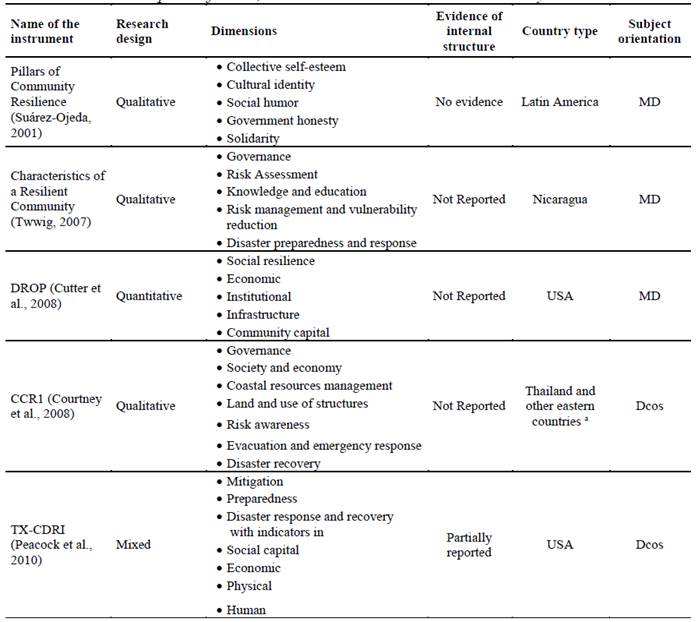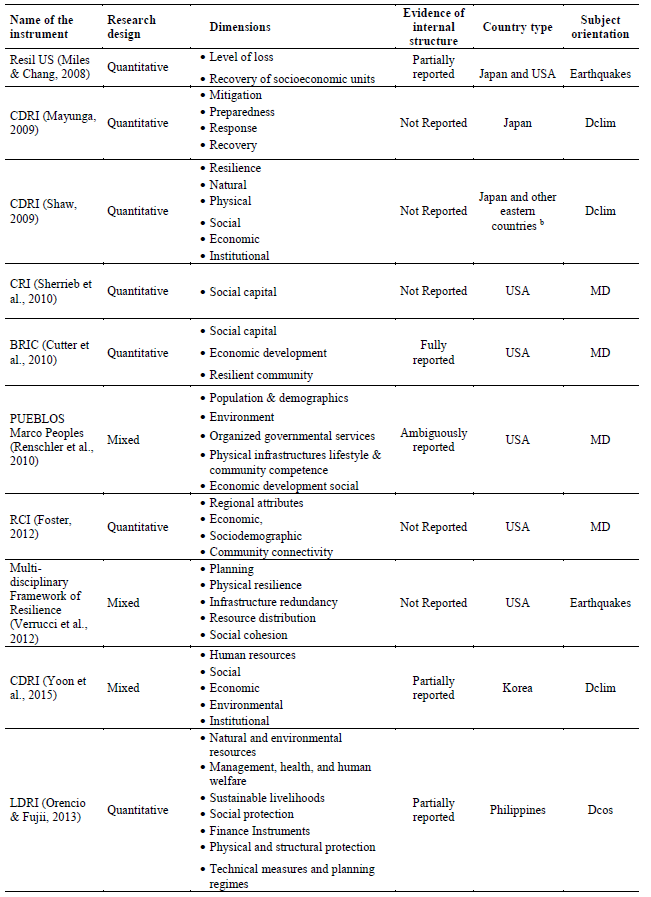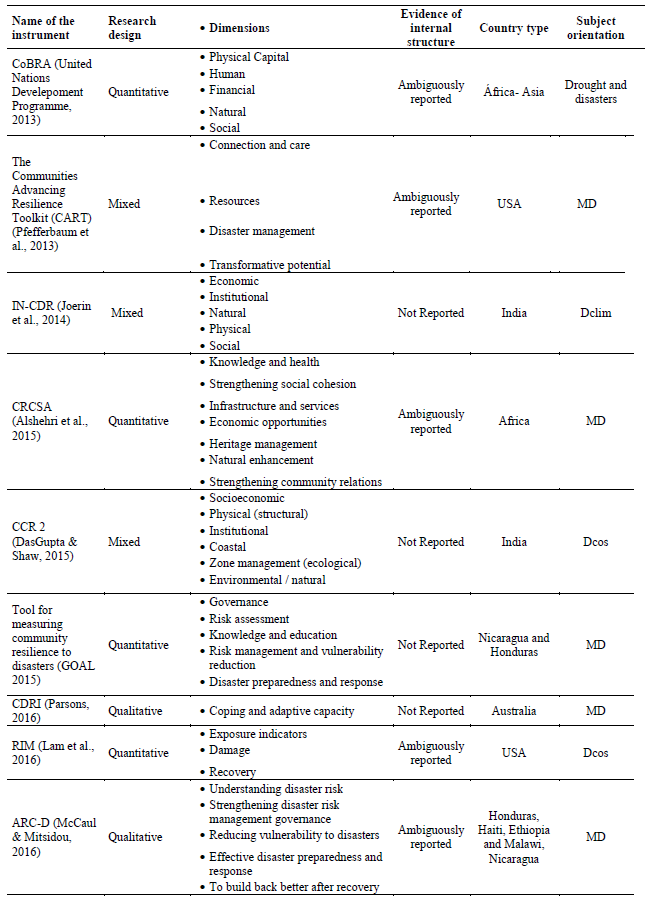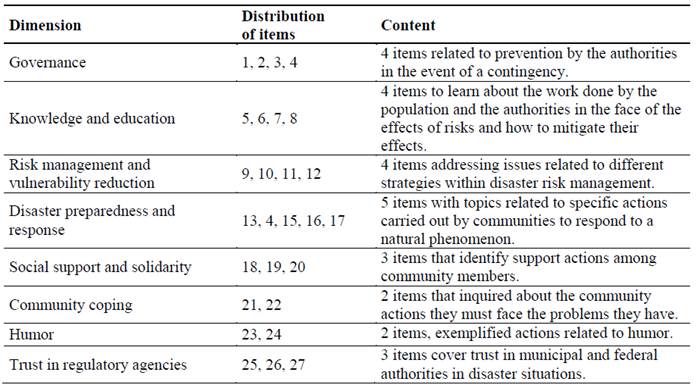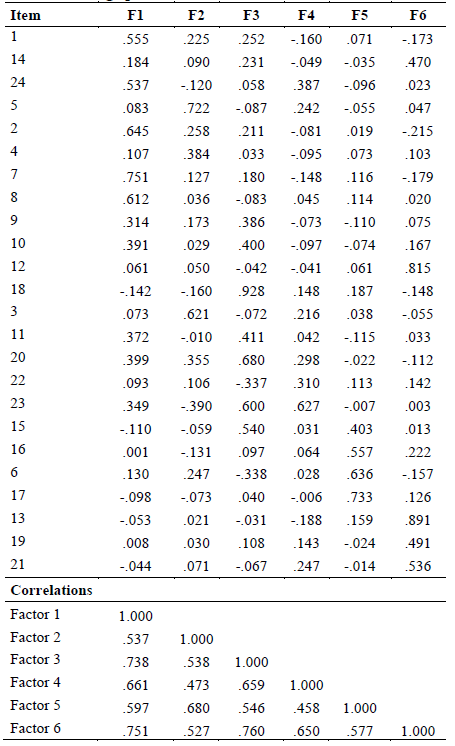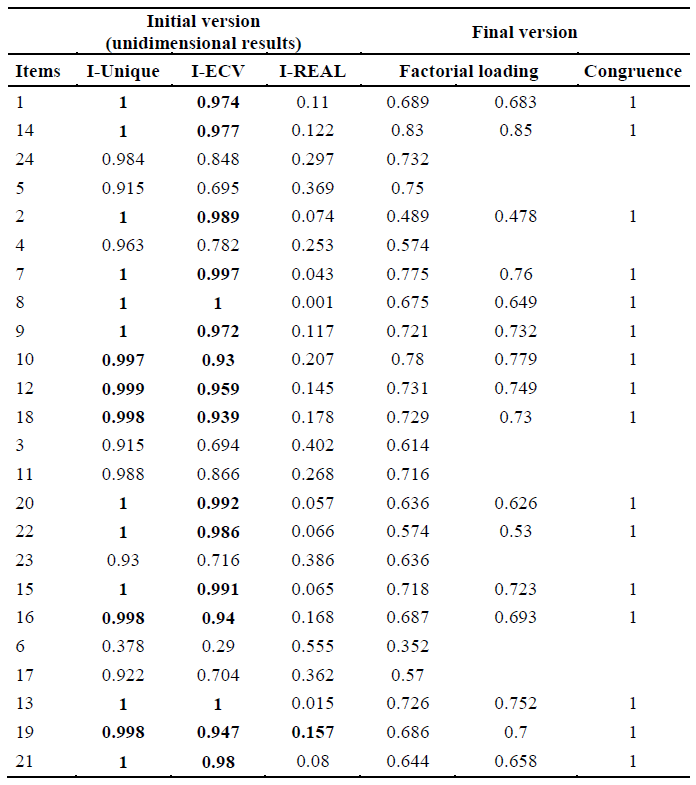Servicios Personalizados
Revista
Articulo
Links relacionados
Compartir
Ciencias Psicológicas
versión impresa ISSN 1688-4094versión On-line ISSN 1688-4221
Cienc. Psicol. vol.16 no.2 Montevideo dic. 2022 Epub 01-Dic-2022
https://doi.org/10.22235/cp.v16i2.2723
Original Article
Construction and validation of a Scale of Community Resilience Facing Natural Hazards
1 Universidad Autónoma del Estado de Morelos, Centro de Investigación Transdisciplinar en Psicología, México, veronica.suarez@uaem.edu.mx
2 Universidad Autónoma del Estado de Morelos, Centro de Investigación Transdisciplinar en Psicología, México
3 Universidad Autónoma del Estado de Morelos, Centro de Investigación Transdisciplinar en Psicología, México
Background: The effects caused by natural phenomena have been increasing, aggravating the vulnerability of exposed populations. It is necessary to measure the resilience capacity of the community to face this type of adverse situations. The objective of the study was the construction and validation of a self-report scale of community resilience. Method: The items were based on the proposal of Twigg (2007) and Suárez-Ojeda (2001). The AIKEN V and semi-confirmatory analysis (McDonald, 2005) were used to validate the instrument. There was a sample of 290 participants with an age range of 18 to 78 years, from the municipalities of Jojutla and Yautepec in the State of Morelos (Mexico). Results: A final unidimensional scale made up of 16 items was obtained, internal consistency Ω = .924. Conclusions: This scale can be useful for those working in integrated disaster risk management.
Keywords: instrument validation; instrument construction; community resilience; risk management; natural hazards
Antecedentes: Los efectos ocasionados por los fenómenos de origen natural han ido en aumento, agravando la vulnerabilidad de las poblaciones expuestas. Resulta necesario medir la capacidad de resiliencia de la comunidad para hacer frente a este tipo de situaciones adversas. El objetivo del estudio fue la construcción y validación de una escala de autoinforme de resiliencia comunitaria. Método: Los ítems se basaron en la propuesta de Twigg (2007) y Suárez-Ojeda (2001). Para la validación del instrumento se empleó la V de Aiken y el análisis semi-confirmatorio (McDonald, 2005). Se contó con una muestra de 290 participantes con un rango de edad de 18 a 78 años, de los municipios de Jojutla y Yautepec del Estado de Morelos (México). Resultados: Se obtuvo una escala final unidimensional conformada por 16 ítems, consistencia interna Ω = .924. Conclusiones: Esta escala puede ser de utilidad para quienes trabajan en la gestión integral de riesgos de desastres.
Palabras clave: validación de instrumentos; construcción de instrumentos; resiliencia comunitaria; gestión de riesgo; amenazas naturales
Antecedentes: Os efeitos causados por fenômenos naturais vêm aumentando, agravando a vulnerabilidade das populações expostas. É necessário mensurar a capacidade de resiliência da comunidade para lidar com esse tipo de situação adversa. O objetivo do estudo foi a construção e a validação de uma escala de autorrelato de resiliência comunitária. Método: Os itens foram baseados na proposta de Twigg (2007) e Suárez-Ojeda (2001). Para validação do instrumento, utilizou-se o V do AIKEN e a análise semiconfirmatória (McDonald, 2005). A amostra foi de 290 participantes, com faixa etária de 18 a 78 anos, dos municípios de Jojutla e Yautepec do Estado de Morelos (México). Resultados: Obteve-se uma escala final unidimensional composta por 16 itens, consistência interna Ω = 0,924. Conclusões: Esta escala pode ser útil para quem trabalha na gestão integral do risco de desastres.
Palavras-chave: validação de instrumento; construção de instrumentos; resiliência comunitária; gerenciamento de riscos; ameaças naturais
Worldwide, the effects caused by hydro-meteorological and geological phenomena in the 20th and 21st centuries have caused economic losses of trillions of dollars; in the social aspect, 4.03 trillion dollars in goods and 1.23 million people were reported dead, as well as environmental damage (United Nations Office for Disaster Risk Reduction (UNDRR), 2020). The United Nations (UN) has emphasized in its strategy for disaster risk reduction, the urgency of promoting preparedness, prevention, mitigation, response, recovery, rehabilitation, reconstruction in the face of a crisis or disaster, and particularly community resilience (Diario Oficial de la Federación, 2014; UNDRR, 2007).
Resilience can be understood as the human capacity to cope with, overcome, and emerge strengthened and even transformed by adverse experiences (Grotberg, 2006). It is not static and is based on a dynamic ability that is adaptive to the situation which can also be considered as an adaptive response to a threat or risk (Singh & Kaur, 2018). Different studies have focused mainly on individual resilience (Bonanno, 2008; Davydov et al., 2010; Luthar & Cicchetti, 2000), but community resilience has started to take more space in the scientific landscape. Community resilience is understood as “the ability of communities and households to anticipate and adapt to risks and to absorb, respond to, and recover from shocks and stresses in a timely and effective manner” (Twigg, 2007, p. 6). It can also be understood as a resilient process from cultural knowledge, social capabilities, and organizational strategies in the face of adversity (López & Limón, 2017). Resilient characteristics are known as attributes or pillars of resilience within which, according to Suárez-Ojeda (2001), are collective self-esteem, cultural identity, social humor, state honesty, and solidarity. Other aspects that influence community resilience are well-being indicators, political, social, economic, physical (Almutairi et al., 2020,) and cultural aspects (De la Yncera, 2019; Lorenzo, 2016).
Population context
This instrument was validated in the state of Morelos, in the communities of Jojutla and Yautepec, which are exposed to natural phenomena of hydrometeorological and geological origin. Earthquakes are events that occur frequently in the Mexican territory; however, they do not occur with the same frequency in the state of Morelos. The earthquake that occurred on September 19, 2017, affected several municipalities in that state, including Jojutla, with two thousand houses affected and 55 people dead. In Yautepec, 870 houses were reported damaged, with no deaths (Diario Oficial de la Federación, 2017). Both municipalities have a high Human Development Index within the state, which allowed the populations to be compared.
Measurement of community resilience
A rapid systematic review was carried out (Haby et al., 2016), with the keywords community resilience scale, in the following search engines: Google Scholar, ELSEVIER, to find out if there was an instrument that could be adapted to the study of community resilience to risk situations of natural phenomena in the Mexican population. The results are shown in table 1a 1b 1c 1d.
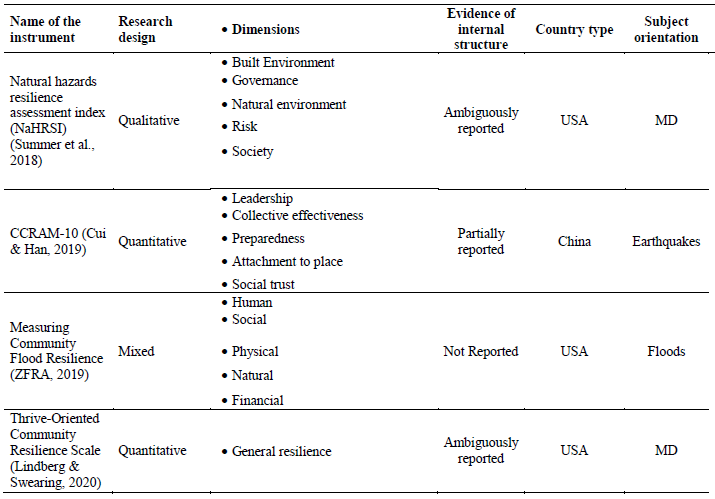
Note: MD: multi-disaster; DC: coastal disasters; DClim: climatic disasters. a Sri Lanka, Indonesia, India and Maldives. b Philippines, Vietnam, India, Indonesia, Thailand, Sri Lanka.
After an in-depth analysis of each of the proposals reviewed on the existing indexes and tools, a gap was observed in the instruments that would make it possible to incorporate into community resilience the risk aspects of natural hazards and the participation of both governmental bodies as well as existing community resources. Based on this, it was considered that Twigg's (2007) theoretical proposal provided the basis for the construction of a comprehensive instrument for the aspects of community resilience in disaster risk situations, which could also be completed with Suárez-Ojeda's (2001) proposal that includes dimensions of social support, solidarity, and social humor. In addition, both authors conducted resilience studies on the Central American population, which shares characteristics with the Mexican population, such as the economy and a history of natural disasters.
Based on the theoretical review of Twigg (2007) and Suárez-Ojeda (2001), the conceptual definitions of the dimensions were chosen as follows: a) Governance: concerning public policies in charge of planning, regulation and integration of institutional systems, alliances between various civil society organizations and community participation; b) Knowledge and education: identifies the information that the population has regarding hazard-risk, vulnerability and impact, as well as the scientific and technical capacities to deal with them; c) Risk management and vulnerability reduction: management of the environment and natural resources, health and welfare of communities, social security through financial instruments, physical protection and technical and structural measures, as well as the implementation of planning systems that seek to reduce vulnerability; d) Disaster preparedness and response: to know the organizational capacity to respond to a natural phenomenon, through early warning systems, preparation and contingency planning, enabling resources and infrastructure to respond to emergencies, as well as establishing protocols for emergency response and recovery with the participation of the government and civil society; e) Social support and solidarity, is the capacity to collaborate with others who require support to move forward, who are part of the community and whose purpose is the search for the common benefit; f) Community coping, is the particular way in which each group faces the adverse situations to which it is exposed: g) Social humor, is the ability to laugh despite the negative things, which are happening in the environment and looking for an optimistic solution to get out of it; h) Trust in regulatory agencies, is the good use of existing resources and managed for the community by local and federal authorities for risk management.
Considering the gap in measurement tools on community resilience in situations of natural hazards, this study developed an instrument inspired by the contributions of two authors. The theoretical dimensions chosen, and the evidence of content validity and internal structure are presented below.
Material and methods
Participants
The sample was selected on a non-probabilistic basis and was formed under the following inclusion criteria: a) having experienced at some point in their lives the effects of a natural disaster (earthquake and/or flood), b) being of legal age, c) having freely approved their participation, d) being a member and resident of these communities. The post-data collection exclusion criteria were unanswered items (missing values) and the identification of multivariate extreme values (outliers).
The selected sample, based on non-probabilistic sampling, consisted of inhabitants of Jojutla (n= 263, 91 %) and Yautepec (n = 27, 9 %), with a total of 290 participants, 55.7 % women and 44.3 % men with an age range of 18 to 79 years (M = 29.4, SD = 14.5). Regarding educational level, 27.9 % had basic education, 39.7 % had high school, 30.2 % had a bachelor's degree, 0.7 % had a graduate degree, and 1.4 % had no studies.
Instrument
In the elaboration of the situations that promote community resilience we relied on the theoretical components proposed by Twigg (2007) and Suárez-Ojeda (2001), considering the eight dimensions explained above.
Procedure
Dimensionality. The instrument was represented by eight dimensions based on the 5 theoretical dimensions proposed by Twigg (2007) and the 3 proposed by Suárez-Ojeda (2001), with correlated expectations. The definitions were elaborated considering their conceptual applicability to the context of the chosen Mexican communities and their potential for generalization to other Latin American contexts, their approximate convergence with other definitions in the literature, their potential to be represented in the content of the items (Delgado-Rico et al., 2012).
Item development. To write the items, the existing literature was reviewed, determining the theoretical model and the operational definition of the dimensions that would make up the instrument. Subsequently, the items were written in the first person, taking care to use clear, homogeneous language in accordance with the proposed dimensions.
As a guideline for response options, a 5-point Likert scale was proposed to give as possible responses the degree of disagreement-agreement, in relation to the items elaborated. A homogeneous length was sought in terms of content and appearance, preventing items from overlapping each other (Martínez et al., 2009). Initially, 27 items were proposed, distributed in 8 theoretical dimensions as shown in table 2.
Expert judges. Once the instrument proposal was integrated, the expert judgment technique was used to submit the questions to the scrutiny of experts in the field, to determine how relevant, the questions of the scale were in relation to the proposed topic (Escobar-Pérez & Cuervo-Martínez, 2008). The group of judges consisted of five psychologists chosen for their verifiable expertise through their publications and field experience in their areas of work in relation to the topic: two full-time academics at universities in Mexico and Chile, and three disaster psychologists who have been part of the Mexican and International Red Cross and the Psychological Attention for Disasters (APSIDE) program. Each was contacted individually and sent a form explaining the instructions for evaluating the content of the items on the criteria of coherence (defined as that the item has a logical relationship with the dimension or indicator being measured), relevance (defined as that the item is essential or important, so it should be included) and clarity (defined as that the item is easily understood, i.e., it has adequate syntax and semantics). They were also asked to make observations and suggestions according to their consideration. Each judge made his or her contributions independently of the other judges. The judges' responses were analyzed by means of Aiken's V coefficient (Aiken, 1985) to see the degree of agreement among the experts in terms of clarity, relevance and coherence. The ICAiken program (Merino-Soto & Livia, 2009) was used.
Participating judges. Because there may be possible discrepancies in the perception of the conceptual relevance and clarity of the items perceived by judges and participants (Merino-Soto, 2016; 2018). A pilot application was carried out to 33 people from one of the communities to be studied, with an age range of 18 to 70 years (M = 34.94; SD = 17.97), of which 60.6 % were men and 39.4 % were women. During the application, the participating judges made observations on the instrument, regarding words that for them had a different meaning or that were not clear and caused confusion in their answers.
Regarding the proposed dimensions, they were unable to differentiate between the dimensions of community support and coping; they considered that they belonged to the same dimension. The humor dimension was not clear to them, and they did not consider it important.
Data cleaning. Data cleaning began with the identification of a) the number of unanswered items in the instrument, and b) multivariate extreme values. The first was done with a simple count of the unanswered items; the second was done by applying the D2 statistic (Mahalanobis, 1936), which obtains the multivariate distance of the data from the centroid response of the variables. The program norm (DeCarlo, 1997) was used. For descriptive statistics, and univariate (Cramér-von-Mises test, CVM; Darling, 1957) and multivariate normality (HZ test; Henze & Zirkler, 1990), the MVN program (Korkmaz, et al., 2014) was used.
Dimensionality. The analysis of the internal structure of the instrument consisted of a combination of exploratory and confirmatory approaches to establish the structure of the instrument. The exploratory approach was applied to verify the number of latent dimensions underlying the data, and to identify the existence of possible redundant dimensions. The number of dimensions proposed for the instrument was six, which served as a hypothesis of dimensionality. A consensus approach (Lüdecke et al., 2020) was used among several dimensionality identification methods, using the programs nFactors (Raiche & Magis, 2020) and psych (Revelle, 2019), integrated into the parameters program (Lüdecke et al., 2020). This approach consists in the maximum convergence of 24 methods regarding the number of possible dimensions.
Internal structure of the items. In the next step, a semi-confirmatory factor analysis was applied (McDonald, 2005). Although in the exploratory stage unidimensionality was suggested as the recommended internal structure, the semi-confirmatory factor analysis was applied to observe the congruence of the items with their factors and the degree of factorial complexity. The Factor 10.10 program (Lorenzo-Seva & Ferrando, 2006) was used, applied to the polychoric correlations between items. To evaluate the congruence between the items with their expected relationship to the factors, the congruence coefficient (Burt, 1948) was used; values greater than 0.90 indicate good congruence (Lorenzo-Seva & Ten Berge, 2006), so we proceeded to review the items that met the congruence index, accepting 16 of these and although unidimensionality was suggested, in the final scale we considered that at least two items from each of the theoretical dimensions should be included.
Data analysis
Expert judges. All expert judges invited to evaluate the items completed the task. Of the 27 items evaluated, only 1 item was considered to have insufficient content validity (clarity, coherence and relevance < .87) and was therefore eliminated. Improvements were made to the wording of 3 items and 1 item was added. Table 3 shows the results obtained with the Aiken V for clarity, coherence and relevance.
Table 3: Degree of agreement among the judges in relation to clarity, coherence and relevance
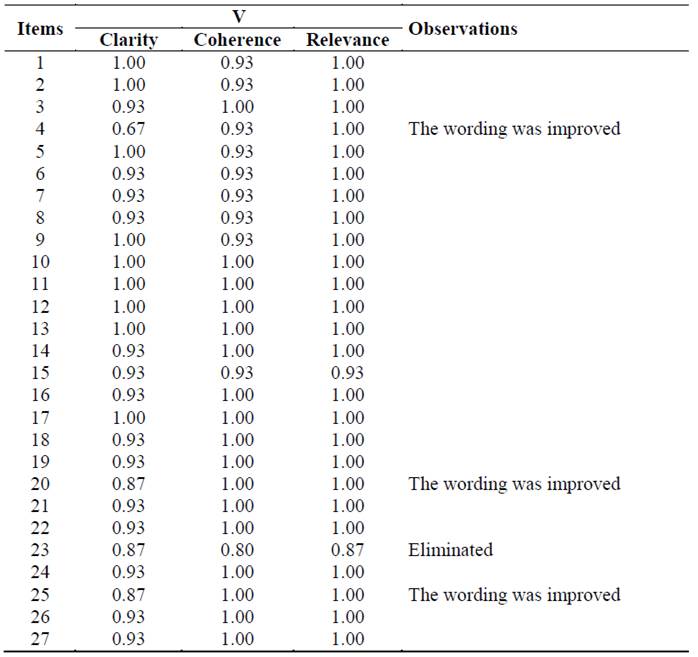
Note: V: AIKEN V Validity Coefficient.
Participating judges. All the participating judges completed the task. They reported that they did not associate the word "disappeared" with the topic of natural disasters but related it to situations of violence and organized crime. Likewise, the questions on the dimensions of humor, community coping, community support and solidarity were not considered relevant, caused them confusion and they mentioned that they were similar.
Subsequently, with the judges' observations and suggestions, it was decided to merge the dimensions of community coping and community support and solidarity into a single theoretical dimension since the wording and content of these dimensions were very similar and their separation only confused the reader. Then, the questions related to the use of humor as a way of coping with danger were eliminated as they were evaluated as irrelevant. At the judges' suggestion, four more items were added to the knowledge and response readiness dimensions, so that the scale for validation consisted of 24 items.
Preliminary analysis. Three cases (1 %) with no response to the items were detected, 2 (6 %) were imputed by the modal value of the item. Regarding the multivariate extreme values, by means of the Mahalanobis distance, 10 participants were detected and eliminated, representing 3.3 % of the sample.
Descriptive analysis of items. The descriptive results of the items are presented. The set of items did not show multivariate normality (Henze-Zirkler test = 1.211, p < .01); this was derived from the absence of univariate normality in each item (Cramer-von Mises test, CVM < .01). On the other hand, there seems to be no restriction in the response range, because the participants used the entire range of options. This similarity in the use of scaling was also observed in the dispersion (standard deviation) of each item as shown in table 4.
Table 4: Descriptive statistics for the Community Resilience Scale items (n = 290)
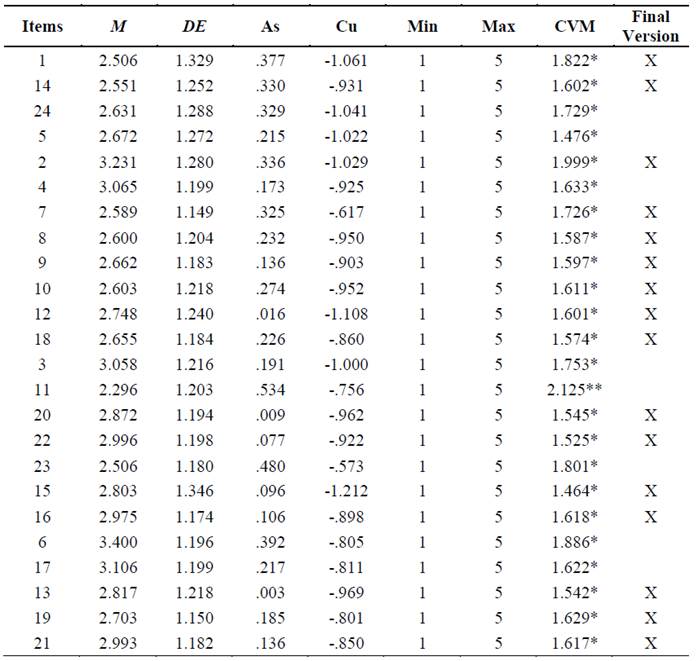
Notes: ERC: community resilience scale; CVM: Cramer von Mises univariate normality; As: skewness coefficient; Cu: coefficient of kurtosis. *p < .05.
Dimensionality. The empirical eigenvalues obtained from the inter-item correlation matrix were as follows (top seven): 10.379, 1.627, 1.105, 1.031, .988, .906, .797. With the application of the consensus approach it was found that a single dimension was suggested by 21.7% of methods based on the hillside plot or scree test (e.g., acceleration factor and multiple regression), VSS (method 2), and model fitting (e.g., TLI and RMSEA coefficients); two factors (8.6 %) by VSS (method 1) and MAP-Velicer; three factors (13.0 %) by CNG, BIC-information and BIC-fitting; 4 factors (21.7 %) by methods predominantly based on the slope graph. Due to the parsimony in the construct representation of the instrument, the difference between the first eigenvalue compared to the rest of the eigenvalues, and that the eigenvalues from the second were comparatively very small with respect to the first, the apparent number of factors suggested for the measurement model was a single dimension.
To examine and verify the apparent strong latent unidimensionality of the instrument items, the factor loadings of the 24 items are shown in table 5. There are items that load on more than one factor, and the correlations between dimensions are considered high, so it was decided to perform a semi-confirmatory analysis.
Table 6 shows the level of congruence with the unidimensionality and the factor loadings, where those that had an I-Unique and I-ECV = or < .95 were considered to be part of the final instrument, forming a unidimensional scale with 16 items that will allow the general measurement of Community Resilience in populations of the state of Morelos that have been exposed to earthquakes and floods.
Also, the 16 items that made up the final instrument, with factor loadings between .478 and .850 (M= .693; Md = .711) are shown in bold. The reliability coefficient Ω was .924. Therefore, it is considered to meet very high values of reliability and internal structure validity.
Discussion
This study presents a scale of Community Resilience for the Mexican population that allows for a general measurement of actions such as risk prevention, preparedness, governance, as well as trust in the authorities in the face of risk situations in a global manner without differentiating between the dimensions initially proposed.
The ways of approaching the analysis of community resilience are complex because they involve the management of social aspects that are intertwined and that cannot always be differentiated in a practical way. It is also necessary to consider the issues to be addressed. A recent study shows the importance of considering, in the study of community resilience, the local problems that affect a community. In such a way that dimensions are structured in this sense (economy, infrastructure, governance, institutions, etc.); for example, in the case of coastal communities, the prevailing themes are social and economic to assess community resilience. However, the frames of reference vary depending on what is sought in each research, as the themes can be very broad (Almutairi et al., 2020). This shows us the complexity of establishing the parameters that should contain the dimensions to be measured when talking about community resilience.
A recent study in North America proposed a scale of resilience to natural hazards, economic shocks and other challenges, aimed at analyzing the progress of perceived community resilience and assessing the contribution of predictors of resilience. However, the authors note that measures of community resilience are potentially combined with predictors and indicators of resilience, resulting in a unidimensional scale that allows measurement based on overall community resilience (Lindberg & Swearing, 2020). We could think that a similar situation is presented in our case since the different theoretical dimensions that were proposed failed to discriminate a difference between them making our instrument a unidimensional scale of community resilience. Despite this situation, our scale meets all the criteria of reliability and validity and therefore offers a way to measure this type of resilience in the face of chronic natural hazards in the Mexican population.
The scale could be validated in other Latin American countries since the theoretical dimensions arose from themes proposed in studies carried out in Latin America. Another particularity of our scale also lies in the fact that it is oriented to measure community resilience from the components of integrated risk management in which both actions of the population and regulatory agencies are involved, obtaining a global indicator of resilience in this issue in the Mexican population.
Conclusions
It is important to point out that the concept of community resilience is a term that, as its name indicates, is developed within the community, considering its own intrinsic and extrinsic characteristics, so it is important to have instruments that take into account the cultural, social and geographic differences of the populations in order to promote resilience actions according to the needs of the community and the exposed risks. Among the limitations of the scale is the fact that it has not been validated in a larger sample. This proposal may be useful for those working in integrated disaster risk management, as it is important to consider the vision of the populations involved in natural hazards.
REFERENCES
Aiken, L. R. (1985). Three coefficients for analyzing the reliability and validity of ratings. Educational and Psychological Measurement, 45, 131-142. https://doi.org/10.1177/0013164485451012 [ Links ]
Almutairi, A., Mourshed, M. & Mohammed, R. (2020). Coastal community resilience frameworks for disaster risk management. Natural Hazards: Journal of the International Society for the Prevention and Mitigation of Natural, 101(2), 595-630. https://doi.org/10.1007/s11069-020-03875-3 [ Links ]
Bonanno, G. (2008). Loss, Trauma, and Human Resilience: Have We Underestimated the Human Capacity to Thrive After Extremely Aversive Events? Psychological Trauma: Theory, Research, Practice, and Policy, 1, 101-113. https://doi.org/10.1037/0003-066X.59.1.20 [ Links ]
Burt, C. (1948). The factorial study of temperament traits. British Journal of Psychology, Statistical Section, 1, 178-203. https://doi.org/10.1111/j.2044-8317.1948.tb00236.x [ Links ]
Darling, D. (1957). The Kolmogorov-Smirnov, Cramer-von Mises Tests. Annals of Mathematic Statistic, 28(4), 823-838. https://doi.org/10.1214/aoms/1177706788 [ Links ]
Davydov, D., Stewart, R., Ritchie, K. & Chaudieu, I. (2010). Resilience and mental Health. Clinical Psychology Review, 30(5), pp. 479-495. [ Links ]
De la Yncera, N. de la C. (2019). Resiliencia comunitaria frente al riesgo de desastre de origen natural en Yautepec, Morelos (Disertación doctoral, Universidad Autónoma del Estado de Morelos). Repositorio Institucional de Acceso Abierto (RIAA) de la Universidad Autónoma del Estado de Morelos. http://riaa.uaem.mx/xmlui/handle/20.500.12055/792 [ Links ]
DeCarlo, L. (1997). On the meaning and use of kurtosis. Psychological Methods, 2(3), 292-307. https://doi.org/10.1037/1082-989X.2.3.292 [ Links ]
Delgado-Rico, E., Carretero-Dios, H., & Willbald, R. (2012). Content validity evidences in test development: An applied perspective. International Journal of Clinical and Health Psychology, 12(3), 449-459. [ Links ]
Diario Oficial de la Federación. (2014, 13 de mayo). Reglamento de la ley General de Protección Civil. https://www.dof.gob.mx/nota_detalle.php?codigo=5344324&fecha=13/05/2014 [ Links ]
Diario Oficial de la Federación. (2017, 28 de septiembre). Declaratoria de Desastre Natural por la ocurrencia de sismo con magnitud 7.1 ocurrido el 19 de septiembre de 2017, en 33 municipios del estado de Morelos. http://www.dof.gob.mx/nota_detalle.php?codigo=5499058&fecha=28/09/2017 [ Links ]
Escobar-Pérez, J. & Cuervo-Martínez, A. (2008). Validez de contenido y juicio de expertos: una aproximación a su utilización. Avances de Medición, 6, 27-36. [ Links ]
Grotberg, E. (2006). ¿Qué entendemos por resiliencia? ¿Cómo promoverla? ¿Cómo utilizarla? En E. Grotberg (Ed.), La resiliencia en el mundo de hoy. Cómo superar las adversidades (pp. 17-57). Gedisa. [ Links ]
Haby, M., Chapman, E., Clark, R., Barreto, J., Reviez, L., & Lavis, J. (2016). What are the best methodologies for rapid reviews of the research evidence for evidence-informed decision making in health policy and practice: a rapid review. Health Research Policy and Systems, 14(83), 1-12. https://doi.org/10.1186/s12961-016-0155-7 [ Links ]
Henze, N. & Zirkler, B. (1990). A class of invariant consistent tests for multivariate normality. Communications in Statistics - Theory and Methods, 19(10), 3595-3618. https://doi.org/10.1080/03610929008830400 [ Links ]
Korkmaz, S., Goksuluk, D., & Zararsiz, G. (2014). MVN: An R package for assessing multivariate normality. The R Journal, 6(2), 151-162. [ Links ]
Lindberg, K. & Swearing, T. (2020). A Reflective Thrive‐Oriented Community Resilience Scale. American Journal of Community Psychology, 65(3-4), 467-478. https://doi.org/10.1002/ajcp.12416 [ Links ]
López, F. & Limón, F. (2017) Componentes del proceso de resiliencia comunitaria: conocimientos culturales, capacidades sociales y estrategias organizativas. PSIENCIA. Revista Latinoamericana de Ciencia Psicológica. 9(3), 1-13. [ Links ]
Lorenzo, A. (2016, 7-11 de noviembre). El entrenamiento histórico cultural como verdadero potenciador de la readaptación psicosocial para la promoción de salud y bienestar en el Caribe a comunidades damnificadas por desastres (Ponencia). Caribbean Regional Conference of Psychology 2016, Puerto Príncipe, Haití. [ Links ]
Lorenzo-Seva, U. & Ten Berge, J. (2006). Tucker's congruence coefficient as a meaningful index of factor similarity. Methodology, 2, 57-64. https://doi.org/10.1027/1614-2241.2.2.57 [ Links ]
Lüdecke, D., Ben-Shachar, M. S., & Makowski, D. (2020). Describe and understand your model’s parameters. CRAN. https://easystats.github.io/parameters. 10.5281/zenodo.3731932 [ Links ]
Luthar, S. & Cicchetti, D. (2000). The construct of resilience: implications for interventions and social policies. Development & Psychopathology, 12(4), 857-885. https://doi.org/10.1017 / s0954579400004156 [ Links ]
Mahalanobis, P. (1936). On the generalised distance in statistics. Sankhya A, 80(S1), 1-7. https://doi.org/10.1007/s13171-019-00164-5 [ Links ]
Martínez, R., Moreno, R., Martin, I., & Trigo, M. (2009). Evaluation of five guidelines for option development in multiple-choice item-writing. Psicothema, 21(2), 326-330. [ Links ]
McDonald, R. (2005). Semi confirmatory factor analysis: the example of anxiety and depression. Structural Equation Modeling: A Multidisciplinary Journal, 12(1), 163-172. https://doi.org/10.1207/s15328007sem1201_9 [ Links ]
Merino-Soto, C. & Livia, J. (2009). Intervalos de confianza asimétricos para el índice la validez de contenido: Un programa Visual Basic para la V de Aiken. Anales de Psicología, 25(1), 169-171. [ Links ]
Merino-Soto, C. (2016). Percepción de la claridad de los ítems: comparación del juicio de estudiantes y jueces-expertos. Revista Latinoamericana de Ciencias Sociales, Niñez y Juventud, 14(2), 1469-1477. https://doi.org/10.11600/1692715x.14239120615 [ Links ]
Raiche, G. & Magis, D. (2020). nFactors: parallel analysis and other non-graphical solutions to the Cattell Scree Test. R package version 2.4.1. https://CRAN.R-project.org/package=nFactors [ Links ]
Revelle, W. (2019). Psych: Procedures for personality and psychological research (Archivo). Northwestern University, Illinois, Estados Unidos. https://CRAN.R-project.org/package=psych. [ Links ]
Singh, G. & Kaur, G. H. (2018) Moderating effect of resilience on role stress: a critical review. ZENITH International Journal of Multidisciplinary Research, 8(1), 114-122. [ Links ]
Suárez-Ojeda, E. (2001). Una concepción Latinoamérica: La Resiliencia Comunitaria. En A. Melillo (Ed.), Resiliencia. Descubriendo las propias fortalezas (pp.67-82). Paidós. [ Links ]
Twigg, J. (2007). Características de una comunidad Resiliente ante los desastres, una nota guía. https://www.eird.org/newsroom/Spanish_Characteristics_disaster_high_res.pdf [ Links ]
United Nations Office for Disaster Risk Reduction. (2007). Hyogo Framework for Action 2005-2015: Building the resilience of nations and communities to disasters. https://www.undrr.org/publication/hyogo-framework-action-2005-2015-building-resilience-nations-and-communities-disasters [ Links ]
United Nations Office for Disaster Risk Reduction. (2020). Human cost of Disaster, An overview of the last 20 years 2000-2019. The United Nations Office for Disaster Risk Reduction. https://www.CRED-Disaster-Report-Human-Cost2000-2019.pdf [ Links ]
How to cite: Suárez Ramos, V., López Vázquez, E., & Merino Soto, C. (2022). Construction and validation of a Scale of Community Resilience Facing Natural Hazards. Ciencias Psicológicas, 16(2), e-2723. https://doi.org/10.22235/cp.v16i2.2723
Authors’ participation: a) Conception and design of the work; b) Data acquisition; c) Analysis and interpretation of data; d) Writing of the manuscript; e) Critical review of the manuscript. V. S. R. has contributed in a, b, c, d; E. L. V. in a, d, e; C. M. S. in c, d, e.
Received: October 24, 2021; Accepted: May 26, 2022











 texto en
texto en 


